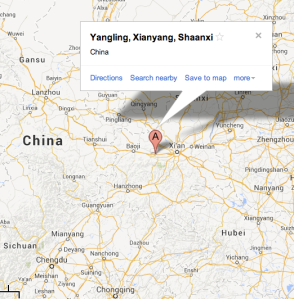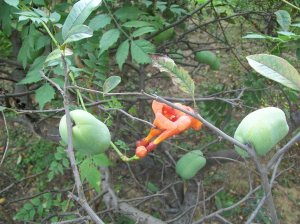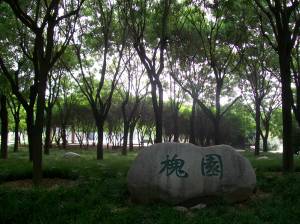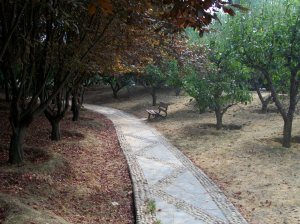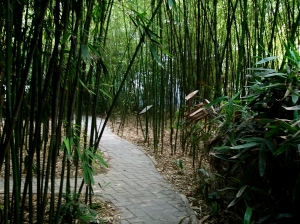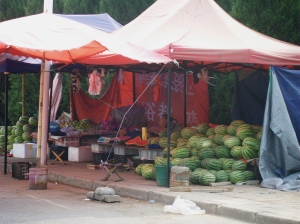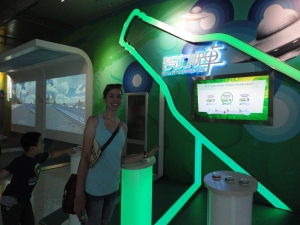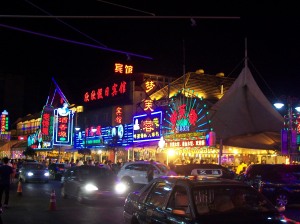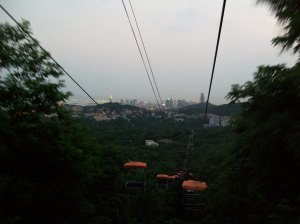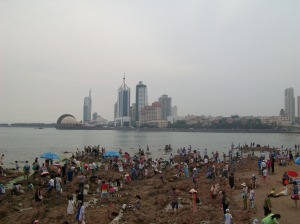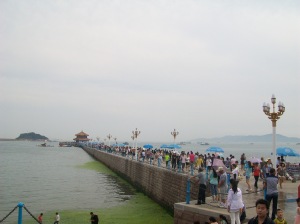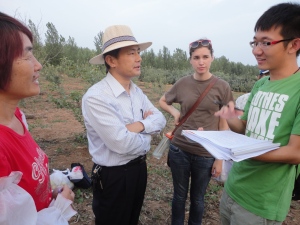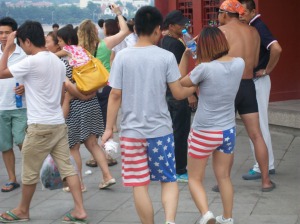As promised, last week Julia and I were able to hang out in Qixia (self-professed apple capital of China) doing the on-the-ground, talking-to-farmers, data-collecting research we’ve been anxious to do since we arrived. As usual, we were given notice of our departure about an hour in advance, so we threw whatever clean-ish clothes were handy in our backpacks and hopped on a bus for the quick (~2 hr) ride to Qixia.
When we arrived we met with a few members of the Qixia Fruit Bureau, who organized our visits to the villages. They dropped us off at the same hotel where we stayed last time, and we had a brief meeting with the Bureau employee who would be responsible for us. We quickly described the research methods we wanted to use, and it occurs to me now that I have yet to do the same for this blog. So here you go:
Basically our methods thus far fall into two categories. First, Julia wrote a survey intended for Chinese apple farmers that investigates how they currently obtain agricultural information and how ICTs (information communication technologies) might serve their unmet needs (or not). It asks questions like “How often do you listen to the radio/watch TV/use the internet?” and “When you have an insect problem in your orchard, what’s the first thing you do to find a solution?” and “Does the weather forecast impact your farming decisions?”
The second method, which I’ve been working on, focuses on the gender aspect of our research. In order to better understand the lives and concerns of women farmers in China, I decided to try out a method called photovoice. This involves giving cameras to research participants and asking them to take photographs that respond to some question or prompt. For example, members of a First Nation community in Canada participating in a photovoice project were asked to take pictures of environmental and health risks in their community. One of the earliest uses of photovoice was a study conducted in Yunnan, China in 1997, where women were asked to take photographs that represented the “spirit” of their village.
After taking the photographs, participants would then meet to discuss their photographs in focus groups, expanding upon the ideas their pictures represented. I had hoped to do something similar in the villages that we visited, asking women farmers to take pictures of things that made their lives more difficult or easier. The advantages of this approach are at least two-fold: 1) The photographs give a marginalized group (women farmers) a tool for expressing themselves that transcends the language barrier between us and 2) the photographs are a launching point for tackling complex issues that can be difficult to begin talking about cold. In addition, by allowing the women to choose the photographs, and therefore the topics of discussion, we can ensure that we address the issues that are most meaningful to them (and may not have otherwise occurred to us).
Back to our meeting with the Fruit Bureau representative – we quickly realized that he had been stuck with baby-sitting us and was none too pleased about it. He wanted us to complete the surveys as quickly as possible, and was very pessimistic about the photovoice idea, saying some rather condescending things about women farmers. After several difficult minutes we finally coaxed him into allowing us to at least try, but we clearly couldn’t count on any assistance from him.
Our first full day in Qixia (Tuesday) our Bureau friend met us at 8:00 and took us to a nearby village. He then handed us off to someone he knew in the village (whose name I never caught) and said he’d see us later. The morning got off to a great start, as our village escort took us to a little shop where a bunch of farmers were hanging out. We happily sat down and started chatted and interviewing people. The survey had been edited down so that it only took 20-30 minutes; people were curious and perfectly willing to answer our questions. Hanging out with those farmers, chatting with people wandering over from the morning market, was probably the highlight of my trip to that point. It was just such a relief to be away from the oversight of the University and the Bureau, talking to farmers one-on-one.
Of course, strictly speaking it wasn’t one-on-one because the bulk of communications went through Yongbo, our fearless translator, but I worked in a few side conversations. These usually begin with farmers asking me (or Yongbo) if I speak/understand Chinese, me replying “Yes, I can speak/understand a little”, and them reacting with delight or skepticism or both. And even Julia was able to work in some of her stock phrases like “My father is a farmer!”
After we finished several surveys, we set about trying to get a photovoice group together. Feeling optimistic from the morning’s success, I delighted that our village guide immediately led us to a group of about eight women hanging out a little ways up the road. We explained the idea of our project to them, and they were really enthusiastic about learning how to use the cameras, smiling and laughing while taking pictures of us and each other. For a moment I felt like everything was finally falling into place, and everything would happen just as I’d imagined it. (I should have known better, of course.) As soon as we started asking whether they would commit to taking photos of their lives, and whether we could come back in a few days to have discussions, they balked and started handing the cameras back, much to my disappointment.
In retrospect, I think our errors are fairly clear. Photovoice is not a commonly used method (not nearly as common as surveys, anyway), and the concept takes some explaining. Add unfamiliarity with the process to the fact that we’re foreigners they’ve just met, and it’s no wonder these women felt wary. They weren’t totally closed to the idea, but we hadn’t given them much time to mull over the process and ask questions, in addition to getting to know us and our goals and motives.
So in the future, I think it’s really important that we first explain the photovoice to a trusted member of the community, and then have them help explain the project to the participants. That way, the idea is just coming from a bunch of strangers, and people are more likely to ask questions. Also, the environment was part of the problem. We were basically just standing to the side of the main road, and a lot of people were dropping in and out of our conversation, including husbands, and I think it’d be better if we were in a more relaxed, less public environment, like someone’s house.
Anyway, lessons learned! We were whisked away to the local government offices for lunch, and then dropped off in the same village afterwards. We spent the rest of the afternoon wandering around the village collecting more surveys. We started by returning to the place where we had done surveys in the morning, but people were pretty absorbed with their card games and mah jong and didn’t really want to talk to us. So we ambled about town and interviewed whoever we ran into – a moderately successful strategy, but time-consuming. We collected eight surveys total that day.
Wednesday was much the same except that our Bureau friend was with us for the whole day, more or less. We started by interviewing a guy who had a fairly large farm, somewhat separate from the main village, and had won a bunch of awards for his apples. He was really friendly and eager to talk to us, and just a cool dude in general. We also made a stop at an inputs dealership and surveyed a farmer there, and then were back to our usual village-based approach. We did a few surveys set up for us in what looked like a classroom with farmers our Bureau guide thought we might like to talk to. Then in the afternoon we were back to wandering around the village on our own, surveying whoever would talk to us. People were generally very friendly – one guy even took a break from house construction (making mortar for ceramic tiles) to talk to us. We seemed to be getting a little more efficient at conducting the survey, and collected 10 total for the day.
On Thursday we were completely on our own – our Bureau guide had guests from Japan visiting, and didn’t have time to help us. We were all a little nervous about striking out on our own, but it actually turned out to be one of our most successful days. We left the hotel early and walked down the street to catch a taxi. Our plan was to tell the taxi driver to take us to a village other than those we had already visited, and just hope that we wouldn’t be run out of town.
Luckily, our driver turned out to be super friendly and helpful (much more than our Bureau friend, actually) and drove us to a village near his own hometown. Even though we were still in the same general area, just outside of Qixia, the drive to this village had scenery totally distinct from where we’d been previously. We were much closer to the mountains, and the views were really gorgeous – orchards on terraced hillsides supported by stone walls, and reservoirs in the valleys. The road we were driving on reminded me of Lesotho (except that it was paved), a single lane twisting around the mountainside, one blind curve after another. I thought Lesotho had given me nerves of steel where mountain-driving-taxis are concerned, but we did have a near head-on collision that really took me by surprise. We were totally fine, but afterward I noticed there was a road sign at that curve that was just a yellow triangle with an exclamation point in the middle, which seemed appropriate.
We exchanged phone numbers with the taxi driver so he could pick us up in the afternoon, and he dropped us off with a farmer in his 70s, just outside the village. He was really friendly and happy to talk to us, so that made us optimistic for the rest of the day. After the survey I asked him about the intercropping we were standing next to – I recognized the peanuts and taro, but not the one in the middle. The farmer said it was called “little red bean”, something used for medicinal purposes. He was a vague as to what purposes exactly, but it had something to do with cooling down the body. We walked into town and found many more people who were happy to complete our survey. We wandered down the main road through the villages, and actually wound up visiting two or three. Everyone was very friendly and pointed us in the direction where they thought we would find more people.
Later in the afternoon when we were interviewing a woman in a small group of other women, I was holding a clipboard and one of the women started looking over my shoulder and reading the survey softly to herself and answering each question out loud as she went. I’ve been more than happy to let Yongbo take the reins on interviews, but I thought, ‘Well, I can at least mark down the answers I understand, as long as she’s answering the questions anyway’, and that is how I found myself conducting a survey in Chinese, with a dialect I barely understood, by myself. Obviously I couldn’t accurately write down the more complicated qualitative answers (like, what aspects of ag TV programs do you like or dislike?), but I could handle the simpler ones pretty easily, like ‘How many mu of apples do you have?’ and ‘Do you use your phone to text’, etc. So I did as much as I could and Yongbo swooped in to fill in the blanks when he was done with his interview. The same thing happened later, and I wound up interviewing a woman while Yongbo interviewed her husband, which was interesting because their answers weren’t identical.
In general people were curious about our survey. At one point we were sitting on stools on a bridge and people kept wandering over to us, so we were able to do 3 consecutive surveys without even moving. This made us a lot more efficient (not getting dragged away by the Bureau guide saved time too), and we were able to collect 18 surveys, twice our previous rate! The weather was also in our favor – unlike the previous two days, it was cool and overcast, so there were undoubtedly more people hanging out outdoors.
The funniest thing was that at the end of the day, we were making arrangements with our taxi driver to come pick us up, and we were trying to figure out which road would take us back to the village where we had started, so we could meet our driver in more or less the same place. We passed an empty taxi parked on a bridge, but we had just called our driver and he said he was on his way, so we presumed it was just some other taxi. However, as we walked through town we passed about a half dozen older villagers, and they insisted that the taxi was ours. We didn’t see how that was possible since we had just talked to the driver, and we hadn’t told him what village we were in. But they were persistent, saying that we should wait there and the driver was coming back.
We had talked to these same people earlier, and didn’t want to appear rude or ungrateful, so we decided to wait, and when the driver arrived it would be clear that there was a misunderstanding. But the villagers noticed our skepticism and assured us that the driver was meeting us at 4:00, which was surprising because it was true – how could they have known that? Sure enough, a few minutes later our very own taxi driver materialized, to our astonishment and pleasure. Apparently when he said he was on his way (“on the road”, in Chinese) his meaning was more literal – he was parked on the village road. It turned out that the last village we visited was his hometown, and, as Julia has often remarked, word travels fast in small towns.
Friday presented a new challenge. Yongbo had to go back to Xi’an (he’s joining his family for a summer vacation) so we were without a translator. Julia and I assumed we wouldn’t be able to do anymore surveys without him, and we were making plans to check out what attractions we could find around Qixia. But to our surprise we found our Bureau friend waiting for us in the hotel lobby with a younger colleague who was willing to serve as our translator. That day’s surveys actually went very well, and we learned another valuable lesson. We told our new translator that we only had 12 more surveys printed off, and that gave us a defined and attainable goal for the day. So, instead of wandering around villages all day on our own trying to complete as many surveys as we could, the people we were working with had motivation to bring farmers to us and complete the surveys as efficiently as possible.
I don’t mean to give the impression that our translator was trying to get rid of us. He was actually very kind and patient, and conscientious in completing our survey according to our instructions. The difference from the previous days was that each time we arrived in the village he spoke to the village leader or someone else with influence, and they helped us track down farmers. Also, because we had a local to explain our survey and purpose to the farmers, they understood our request and agreed much more quickly than when we approached farmers on our own.
Again, I helped out with the interview whenever we were in group setting and could get a farmer started with the simple, straightforward questions. Eventually we found ourselves in a classroom doing something of an interview cascade, with the translator and me doing surveys separately as people came (were called) in, and a guy who came along from lunch helping out, and even Julia jumping into the fray, and the translator cleaning up after all of us. In this way we finished 8 surveys in a little over an hour. The atmosphere in the room was really pleasant – kind of a survey party, with everyone happy to be there & a team spirit. So we’ve taken note may use explicit daily goals to help move things along in Shaanxi.
We returned to QAU on Saturday, and have had a fairly relaxed few days since. The weather is heating up noticeably, and I don’t think it’ll be any cooler in Shaanxi. We’ve been working on trying to get a focus group of women together (without the photography component) and meeting with graduate students here to help them with their English abstracts. In three days we’re off to Xi’an for part two of our summer!
Stray thoughts:
- Everyone thinks we’re Russian. On the street, in the villages – the first question people always have (after “Do you speak Chinese?”) is “Are you Russian?” I have no explanation for this, but it happened multiple times a day in and around Qixia.
- Peaches are in season and piled high on the street vendor carts, and they are delicious. So far all are the sweeter, milder white peach variety.
- You may have heard that dialects of Chinese vary widely throughout the country, and Shandong is no exception. For the most part Yongbo can communicate with rural villagers in his standard Mandarin, but the difference in accents is obvious. At one point one of the villagers I was talking to said she had 9 mu of apple trees, and if she hadn’t made the hand symbol for 9 (a hooked index finger) I never would have guessed that that’s what she was saying.
- Yongbo is the greatest translator ever. That is all.
- There’s apparently something of a drought around Qixia (most obvious to me from the corn, which had extremely spiky leaves). So when we were walking through and between villages on Thursday, we kept seeing tricycle trucks loading up big plastic barrels of water from the reservoirs to take to the orchards for irrigation.
- Sometimes villagers would invite us into their homes to conduct interviews, and several of them had these really interesting traditional beds. They’re made of brick or concrete and built into the house in such a way that smoke is channeled underneath it from the cooking fire before exiting through the chimney. Sounds like it’d be pretty cozy in the winter. (And it’s adjusted somehow so it’s not heated up in the summer.)
